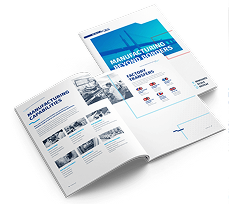Established OEMs with ambitious growth goals often hit a wall as they try to expand their product ranges. Internal design and development (D&D) teams can become overloaded as they juggle updates to legacy products, lifecycle management, and integration of new features.Meanwhile, the pressure to innovate and accelerate time-to-market of new products may be mounting fast.
For many, the answer is clear: outsource D&D. But choosing the right partner is anything but straightforward.
This is the tipping point. OEMs often need to work fast to choose a D&D partner or face a vicious cycle of competing demands and delays that impact revenue.
The product design and development bottleneck
.webp?width=1200&height=1186&name=The-Internal-D%26D-Bottleneck-Infographic%20(1).webp)
Beware: time and budget pressures can lead to costly mistakes
At this stage, the drive for budget-friendly solutions may be pressing. The pressure to launch products first and fast, or accelerate complex life-science development cycles can be extreme.
But not all D&D outsourcing solutions lead to scalable, production-ready outcomes which you can build upon. Choosing the wrong partner can cost you time, quality and credibility in the marketplace.
How to choose the right D&D partner: 9 critical checks
Outsourcing design and development isn’t just about reducing internal workload - it’s about accelerating innovation without compromising quality, control, or time-to-market.
To make the right decision, OEMs must look beyond surface-level promises.
Here are nine critical areas to scrutinise when evaluating a potential D&D partner:
1. Proven sector experience
A capable D&D partner should already understand the unique technical, regulatory, and operational challenges of your industry. Whether it’s medical, industrial, automotive, or IoT, they must have a track record of delivering similar product types.
Look for verifiable case studies, published project outcomes, and references from customers operating in the same sectors. This experience ensures they can anticipate common pitfalls, recommend best practices, and deliver faster - because they’ve done it before.
For example, when the team behind the cutting-edge fertility tracker breathe ilo was looking for an outsourcing D&D partner, they needed reassurance that their complex device could be redesigned for manufacturing and scaled fast without compromising ISO 13485, FDA, or GMP compliance.
We spoke to a lot of companies. But it became clear that very few had the DfX skills, as well as the international manufacturing capabilities and staff to match all our future needs. We found only one company had the specific skills to help us continually modify and improve the product to meet the latest, global med tech standards.
Lisa Krapinger-Rüther, Co-CEO of breathe ilo
2. Transparent, in-house design capabilities
Many EMS companies claim to offer full design services, but the reality often includes significant outsourcing or superficial capabilities.
Insist on full transparency. Do they have named engineering teams with visible, real-world experience? Can you find design staff on LinkedIn or technical leaders contributing to proposals?
Do they offer clearly defined Design for Excellence (DFX) packages and examples of IP they’ve helped develop?
In-house D&D means better collaboration, shorter feedback loops, and clearer accountability across the product lifecycle.
3. Can they help you with every stage of the prototyping process?
A strong prototype isn’t just about proving your idea works - it’s about making sure it will thrive in the real world. Your D&D partner should bring multiple prototyping perspectives to the table from day one:
- Manufacturing view: Can it be built at scale, cost-effectively?
- User view: Is it intuitive and seamless to operate?
- Compliance view: Does it meet every relevant regulation from the start?
- Supply chain view: Can it be sourced, assembled, and delivered reliably?
Partners who integrate these viewpoints early in the process can anticipate challenges before they become expensive setbacks. Look for evidence that they run prototypes as real-world trial runs - testing manufacturability, regulatory readiness, and usability simultaneously, rather than in disconnected phases.
This whole-picture approach ensures that when your product moves from prototype to production, there are no unwelcome surprises - just a smooth transition to market.
Read my colleague Stefan Beer’s excellent article about prototyping capabilities and why they are so integral to any D&D partnership.
4. Breadth of technical capability
Modern product development spans multiple disciplines. A strong outsourcing partner must be technically equipped across three essential pillars.
- Engineering disciplines – including software development, embedded systems, electronics design, and mechanical engineering.
- Manufacturing readiness – covering PCBA, box-build, mechatronics, microelectronics, and prototyping.
- Advanced technology integration – such as AI, IoT, edge processing, sensor fusion (LIDAR, TOF), and other complex features.
Choosing a D&D partner who are also manufacturing experts, will obviously give you a commercial advantage here.
5. Global footprint with local support
Today’s OEMs often need a global production strategy but with local access for design, collaboration, or validation. The ideal D&D partner should support agile development in your region (e.g., Europe or North America), but offer cost-efficient manufacturing options in Asia or Eastern Europe. Look for facilities that comply with local and international standards, possess regional certifications, and have demonstrated experience with cross-border logistics, customs, and regulatory frameworks. Flexibility here ensures your product can scale globally without being redesigned for different regions.
6. OEMs need to be clear who will own the IP when they outsource D&D
You need to confirm who owns the IP, code, and design files upon project completion. Verifying this upfront avoids nasty surprises later, especially during critical handover from design to production
For OEMs, retaining control of your product’s intellectual property - including full design documentation and the Bill of Materials - isn’t just good practice, it’s essential for long-term flexibility and business continuity.
Without it, you risk losing the ability to manufacture, modify, or even service your own product without costly delays and re-engineering work.
At ESCATEC, we’ve seen many OEMs discover too late that their previous partner wouldn’t release the Bill of Materials or design files from the D&D phase. To take over production, we had to fully dismantle and reverse-engineer the product — rebuilding every detail of its design from the ground up.
Neil Sharp, Director Corporate Marketing at ESCATEC
7. Ensure pricing transparency - with flexibility
Budget predictability is vital, especially in early-stage engagements. Look for partners offering fixed-price Design for Excellence (DFX) packages that define scope and deliverables up front-ideal for initial feasibility or concept work. For larger, evolving projects, a Time & Materials (T&M) model ensures flexibility while keeping costs transparent and controllable.
The key is visibility: will the partner give you live budget tracking, issue burn-down reports, and proactively flag scope creep? A transparent pricing model builds trust and helps you plan with confidence.
8. A disciplined shortlisting process
Don’t jump at the first proposal. Start broad - identify 8 to 10 potential partners using referrals, industry networks, and online research. From there, quickly narrow the list based on clear criteria: technical capability, cultural fit, regional presence, and responsiveness. Create a shortlist of 3–5 serious contenders. Conduct interviews, review sample documentation, and if possible, organise facility tours. Most importantly, meet the engineers - not just the salespeople. Great technology partnerships begin with human relationships, not just pricing spreadsheets.
9. Avoid common pitfalls
The most common outsourcing mistakes stem from unrealistic expectations and poorly defined scopes. Don’t assume you’re getting a physical prototype when you’ve only paid for design files. Don’t fall for slick marketing that hides a lack of technical depth. Be cautious of timelines driven by trade show dates or executive pressure. Rushing can lead to shortcuts.
And never choose a partner based solely on price; low cost often means low capability, poor scalability, or hidden rework costs down the line. The right partner adds value at every stage - not just a low number on a quote.
It's a relationship, not just a contract
Your D&D partner shouldn't just be a vendor. They should be a strategic extension of your team. Established OEM teams that succeed in product development often build long-term partnerships with trusted external teams - relationships based on transparency, mutual accountability, and shared expertise.
You don’t want to emerge from the end of a D&D process only to discover you don’t own the IP of the product your partner has helped you develop - or that they simply won’t release the designs to you.
Equally, you don't want to end up with a set of plans that are not designed for manufacturability, with components that are not easily available or on the point of obsolescence. 

